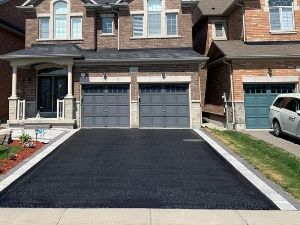
Over time, asphalt can start to develop issues that can be as small as a slight crack to as big as a large indentation that runs through the entire surface. There are numerous issues you can face when you have asphalt installed on your property with, luckily, equally as many fixes.
Throughout this article, we will go through some of the more common asphalt issues you may face, as well as touching on how to go about getting them fixed.
Cracking
We will start off with the most common problem that occurs to asphalt - cracks. There are many different types of cracks that could occur in asphalt. Here are some of the more common cracks and how to fix them.
Alligator Cracking: The name of the crack comes from its appearance which has a resemblance to an alligator’s back. This is caused by structural failure. If alligator cracks go untreated they could form into potholes.
Due to alligator cracking being a sign of structural failure, you will need a full-depth patch to fix it.
Longitudinal Cracking: Longitudinal cracking takes place in the centerline of the pavement and usually runs the length of the pavement. These cracks are usually a result of poor joint construction or pavement fatigue.
For less severe longitudinal cracking, having them sealed is necessary to prevent moisture from getting in and causing more damage. More severe cracks must be removed and replaced.
Transverse Cracking: Transverse cracks go through the center of the pavement, or in the direction it was laid, and are usually caused by reflective cracks or poor construction.
Transverse cracking shares the same fix and longitudinal cracks.
Block Cracking: Block cracks are large interconnected cracks. They are usually caused by shrinkage of the asphalt possibly due to the asphalt being too dry when it was mixed and placed.
Block cracking shares the same fix as both longitudinal and transverse cracking.
Joint Reflection Cracks: Joint reflection cracks occur in flexible pavement overlays of rigid pavement, typically over underlying rigid pavement joints.
Joint reflection cracking shares the same fix as longitudinal, transverse cracking, and block cracking.
Edge Cracks: Edge cracks form near the edge of the pavement, hence the name. This is usually caused by poor support at the edges of the pavement.
Edge cracks are often repaired by simply filling or sealing them. However, poor support issues must be addressed in order to prevent future problems.
Slippage Cracks: Slippage cracks are crescent-shaped cracks in the surface layer of the asphalt. They occur when the slippage of the underlying asphalt layer is not strong enough to bond between layers.
Areas that have slippage cracks will have to be removed and a partial, or full-depth, a patch is required for it to be repaired.
Depressions
Depressions, also known as birthbaths, can lead to much bigger damage down the road. Essentially, these are divots in the road that accumulate water. The reason this small issue can lead to large problems is that the water that collects in the asphalt will begin to weaken the surface and lead to large cracks. They are usually caused by a poor foundation under the asphalt with weak or uneven spots, which causes the pavement to begin to collapse.
Depressions can be fixed with a surface patch if it is minor. For more major depressions, the affected area will have to be removed and replaced.
Potholes
The result of severe, untreated depressions is potholes. Like depressions, potholes are formed from prolonged moisture which can cause damage all the way down to the base level of the asphalt. After cracking becomes severe, cracks create chunks of pavement, those cracks are then dislodged, which is how potholes are formed. They are small bowl-shaped depressions that typically have sharp edges with cracks surrounding the hole.
To fix potholes you will need a full depth replacement patch before problems become worse.
Upheaval
Upheaval is an upward shift in the pavement that occurs when there is swelling of the subgrade. This is sometimes caused by soil that swells up after becoming moist.
When upheaval occurs, it will take a full-depth patch to be repaired.
Shoving
Shoving or wash-boarding is a formation of ripples across the pavement. This is usually caused by horizontal stress and typically happens at intersections. Too fine aggregate, too rounded aggregate, too much asphalt, too soft asphalt, or a weak granular base are some of the reasons shoving develops.
To repair shoving you will need a full-depth patch.

If you have encountered any of the problems listed above, call Action Home Service. We have expert asphalt repair services, covering commercial and residential asphalt repair, catch basin repair, paving, cracking filling, pothole repair, and more.
Give us a call today at (647) 937-1023 to request a free quote and we can talk more about asphalt repair.


